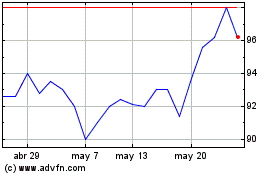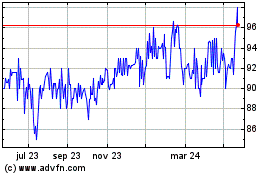Quarterly Review (1758427)
26 Octubre 2023 - 6:48AM
UK Regulatory
M&G Credit Income Investment Trust plc (MGCI)
Quarterly Review
26-Oct-2023 / 12:48 GMT/BST
=----------------------------------------------------------------------------------------------------------------------
M&G CREDIT INCOME INVESTMENT TRUST PLC
(the "Company")
LEI: 549300E9W63X1E5A3N24
Quarterly Review
The Company announces that its quarterly review as at 30 September 2023 is now available, a summary of which is
provided below. The full quarterly review is available on the Company's website at:
https://www.mandg.com/dam/investments/common/gb/en/documents/funds-literature/credit-income-investment-trust/
mandg_credit-income-investment-trust_quarterly-review_gb_eng.pdf
Market Review
The third quarter was characterised by a shift in financial markets toward an acceptance that central banks would keep
interest rates elevated for a prolonged period. This saw government bond yields hit fresh multi-year highs while
investors pulled back from risk assets. The period had started on a positive footing as a notable deceleration in
inflation in Europe and the US saw soft landing expectations drive a strong rally in risk assets, supported by lots of
good news all round from an economic standpoint. As the period progressed however, the early summer optimism lost
momentum as concerns grew over a new era of higher interest rates and central banks' determination to bring inflation
under control with restrictive policies weighed heavily. In the US, fiscal positioning and growing debt levels, not to
mention a credit downgrade by ratings agency Fitch, dented investor appetite for US Treasuries, which contributed to
the significant climb higher in yields. Eurozone and UK government bonds sold off also, although the latter proved
slightly more resilient, outperforming other core sovereign debt over the period. UK corporate bonds were stronger over
the quarter compared to the previous period and versus regional rivals (US and Europe), boosted by broadly flat
government bond yields and some tightening of credit spreads.
With rates likely to stay 'high for longer', attention focused on the potential lagged effects of rate rises on
economic activity. The US economy remained resilient in the period, with GDP data showing growth at an annual rate of
2.1% for the second quarter, partly as wage growth supported consumer spending. The UK economy expanded 0.2% in the
second quarter from the previous quarter and retail sales rose in August. Revised data showed that the UK economy was
now bigger than its pre-pandemic size, and having long been identified as the worst performing economy among G7
countries since the Covid-19 pandemic, also showed that the UK had actually outperformed both Germany and France over
the same period. There were fresh signs of frailty in the Euro-area economy as a succession of weak economic data
releases pointed to a slowdown in activity, leading to concerns that the single-currency bloc could be heading for
recession.
Manager Commentary
Pleasingly the Company delivered another quarter of strongly positive performance. The Company's NAV total return in Q3
was +3.10% which outperformed comparative fixed income indices such as the ICE BofA Sterling Corporate and
Collateralised Index (+2.22%) and the ICE BofA High Yield Index (+1.72%). Performance was driven by a relatively equal
combination of income and capital gains. Our short position in UK 10 year gilt futures continued to mitigate against
the negative effect of rising interest rates, allowing returns to capture the positive contribution of a tightening in
portfolio credit spreads over the quarter. Our strategy of combining higher yielding private assets alongside a smaller
allocation to mainly investment grade, public credit whilst maintaining low duration has proved to be very successful
over the past 12 months, with the Company's 1-year NAV total return 10.35% as at the end of September.
It was a relatively quiet quarter for portfolio activity and although we are reluctant to chase yield at current credit
spread levels, we did continue to add risk selectively. Senior unsecured positions in financial bonds have performed
well for us recently and we took the opportunity to add similar positions in Virgin Money in the secondary market and
Principality at new issue. Following recent private asset repayments, we invested GBP4m into the daily dealing M&G Senior
Asset Backed Credit Fund. The fund invests in a diversified pool of investment grade ABS, predominantly in senior
tranches with 80% or more expected to be of a credit rating of at least AA- or higher. The current average credit
rating of the portfolio is AAA and it returns at present approximately SONIA+150bps. We will use the fund as a
cash-park vehicle while we wait for attractively priced public and private opportunities to arise. In September we
completed the secondary market purchase of two tranches (GBP1.3m) in a public securitisation which was issued by Telereal
in 2008 to fund the sale and leaseback transaction of British Telecom telephone exchanges. The B7 and C1 notes were
purchased at 90 and 91 respectively giving all-in yields of more than 10% for BBB risk. We also sold our bonds from
public high yield borrower Oriflame, with the outlook becoming particularly negative and the turnaround story looking
increasingly difficult to execute.
Outlook
Despite the disinflationary progress seen over the third quarter, a straight line return to a 2% inflation target seems
improbable and recent notable increases in oil and natural gas prices have already resulted in upside surprises in UK
and US CPI data. If the last two months are any indication of future inflation, core US CPI will likely end the year
well above the Fed's target, necessitating interest rates to remain in restrictive territory as they look to wrestle
stubborn inflation back under control. Labour force pressure, strikes and wage growth have been established as
prominent features of the macro landscape in the short term and will complicate the job of policymakers as they attempt
to prevent inflation from becoming embedded. That said, the lagged effect from rate hiking cycles is starting to be
felt in the real economy and lending conditions in both the US and Europe have tightened considerably in the second
half of the year and are in line with levels historically only observed around recessions.
High debt accompanied by high interest rates is an unhealthy dynamic that will ramp up stress within the economy. While
policy rates remain elevated, the inherent risk is that something, somewhere in the financial system will break. So far
issuers in corporate debt markets have been fairly well insulated from the rise in interest rates with many having
termed out debt maturities at lower interest rates in previous years. However, if central banks do as they have been
signalling and keep interest rates higher for longer, the inflection point is fast approaching when many issuers are
forced to refinance large debt piles at significantly higher coupons and defaults will almost certainly increase over
the next two years.
With Europe still reeling from Russia's invasion of Ukraine, a dramatic escalation in geopolitical tensions in the
Middle East has added another layer of complexity to an already uncertain economic outlook. It is too early to say what
impact the Israeli-Palestinian conflict will have on global supply chains and energy prices, with much depending on how
much the war escalates between the two countries and whether it spreads out into a broader regional conflict. Should
the situation develop and involve other global players and allies, the potential human and economic cost would have
significant ramifications on a global scale.
We remain cautious on adding risk at current credit spread levels but we are positioned to move quickly should market
volatility present opportunities, supported by the Company's undrawn GBP25m credit facility. Economic indicators are
showing a deterioration in financial conditions although we are yet to really see this reflected in credit market
pricing except at the riskiest end of the spectrum. Under current market conditions we will continue to look to rotate
out of lower yielding public bonds and into private credit as and when new transactions become available, capturing the
illiquidity premium which has been re-established over the course of the year.
Link Company Matters Limited
Company Secretary
26 October 2023
- ENDS -
The content of the Company's web-pages and the content of any website or pages which may be accessed through hyperlinks
on the Company's web-pages, other than the content of the Update referred to above, is neither incorporated into nor
forms part of the above announcement.
=----------------------------------------------------------------------------------------------------------------------
Dissemination of a Regulatory Announcement, transmitted by EQS Group.
The issuer is solely responsible for the content of this announcement.
=----------------------------------------------------------------------------------------------------------------------
ISIN: GB00BFYYL325, GB00BFYYT831
Category Code: MSCL
TIDM: MGCI
LEI Code: 549300E9W63X1E5A3N24
Sequence No.: 280848
EQS News ID: 1758427
End of Announcement EQS News Service
=------------------------------------------------------------------------------------
Image link:
https://eqs-cockpit.com/cgi-bin/fncls.ssp?fn=show_t_gif&application_id=1758427&application_name=news
(END) Dow Jones Newswires
October 26, 2023 07:48 ET (11:48 GMT)
M&g Credit Income Invest... (LSE:MGCI)
Gráfica de Acción Histórica
De Abr 2024 a May 2024

M&g Credit Income Invest... (LSE:MGCI)
Gráfica de Acción Histórica
De May 2023 a May 2024
